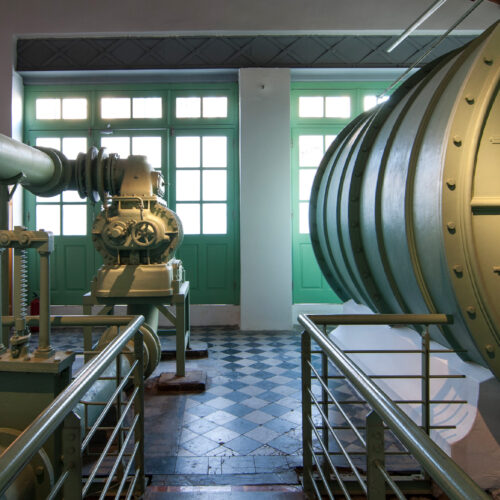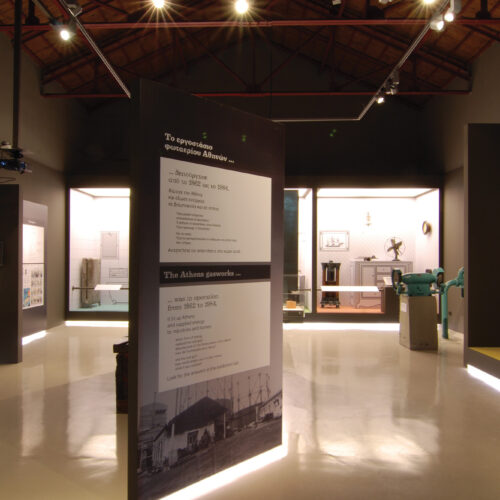The building was constructed in the early 20th century. Coal gas was produced inside the retorts.
Things to learn:
What does “industrial heritage” actually include?
When was “industrial archaeology” established as a scientific field?
How did inventors change history?
*Photo: Industrial Gas Museum Collection | G. Machairas Archive
Chimney B, 34 meters high, was constructed around 1900.
It is connected to the New Retorts building and was used to release the harmful gases of coke.
Things to learn:
The discovery of coal gas and its distribution to city growth
The history and facilities of the Athens gasworks
The Babcock & Wilcox steam boilers their importance in the production line
*Photo: Industrial Gas Museum Collection | G. Machairas Archive
The building was constructed around 1860.
Learn how coal gas was produced inside the retorts by the distillation of coal.
*Photo: Industrial Gas Museum Collection | G. Machairas Archive
Learn about the production workers and the working conditions in the factory.
Go through the photography series "Gazi" by Nikos Markos!
*Photo: Industrial Gas Museum Collection | N. Markos Archive
In the Old Retorts building, learn about the businessmen and politicians who played an important role in the factory, the specialties of worker at the plant, as well as, the relationship between the employees and the management.
*Photo: Industrial Gas Museum Collection | G. Machairas Archive
In the Upper level B, learn about other gasworks in Greece and Europe and enjoy the view of the retorts from above!
*Photo: Industrial Gas Museum Collection
The exhausters date back to the late 19th century. They were manufactured in Berlin, while the steam engines came from Liège.
Learn their function and technology!
*Photo: Industrial Gas Museum Collection | G. Machairas Archive
The Condensers are 168 vertical pipes, 6 meters in height, that were first placed in the factory in 1893 (later construction 1905).
Learn about their function and the importance of water to the plant
*Photo: Industrial Gas Museum Collection | G. Machairas Archive
The building was constructed in the early 20th century.
Coal gas was purified from tar, naphthalene and ammonia.
Things to learn:
Coal gas by products and their utilization.
*Photo: ammonia or naphthalene washers.
*Photo: Industrial Gas Museum Collection | G. Machairas Archive
The building was constructed in the early 20th century. Learn the coal gas purification from sulfureted hydrogen.
*Photo: Purifier tanks from hydrogen sulfide removal.
*Photo: Industrial Gas Museum Collection | G. Machairas Archive
Discover a French gas meter (1902), and a German one (1930) used to measure the amount of purified coal gas!
Today, there are three gasholders in the Athenian Gasworks
They are datet from 1860, 1900 and 1909.
The surplus of coal gas was stored before being distributed to the city network.
Learn about their function and if any of them has been eventually reused?
*Photo: Industrial Gas Museum Collection | G. Machairas Archive
It was constructed around 1864.
Learn about gas meters and see different types of them. Also, be informed about street lighting and gas distribution network!
*Photo: Gas distribution panel for the four main network pipelines
*Photo: Industrial Gas Museum Collection | G. Machairas Archive
It was constructed around 1900.
It was the venue where workers repaired various tools
and did general forging works.
Learn about the uses of coal gas in daily life and the new forms of energy.
*Photo: Industrial Gas Museum Collection | G. Machairas Archive
The Observatory at the New Watergas Tower, the tallest building in Technopolis, invites visitors to have breathtaking view of the city! Enjoy 360Ο views from the Acropolis and Lycabettus Hill to the western suburbs and Egaleo, Faliro and Kastella. And for those wishing to have a closer look, there are binoculars to use! Don’t forget to use your mobile phone to navigate the AR application “Athens Industry”! Discover well known industries an iconic building of Athens dating from 1840 to the 20th century.
The New Watergas was constructed in 1952 to supplement energy production. Its operation was interrupted when the Gasworks closed in 1984. Its highest point, the “Tower”, is 30 meters above the ground. It is the only surviving water gas production building in Europe, a rare example of industrial heritage, as it preserves most of its mechanical equipment.


















